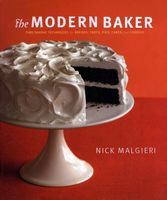Advertisement
Puff Pastries
Appears in
Published 2008

Shatteringly crisp and intensely buttery, puff pastry occupies a unique place among pastry doughs. No other dough can replicate its delicate texture and flavor. Puff pastry preparation used to be time consuming, with long rests between multiple rollings and foldings of the dough, but no more. The recipe for puff pastry in this chapter needs to be rolled out only once—then it’s shaped and chilled and ready for use in an hour or so. I jokingly refer to it as “instant,” but it’s not far from it.
Puff pastry needs to have a fairly strong gluten development or the layers of dough and butter won’t have the necessary strength to puff away from one another during baking. In well-made puff pastry, the initial dough is kept very slack, developing only a weak gluten. All the elasticity of puff pastry is developed during the rolling and folding, resulting in a dough that rises well, shrinks minimally, and is tender when baked. Developing the gluten in the dough too much before folding and rolling in the butter will result in a dough that is difficult to roll, both during the folding process, and afterward when it is rolled to make a finished pastry.

